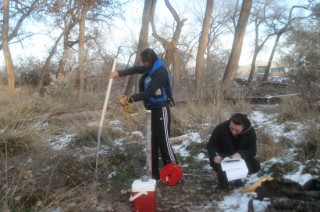How does industrial waste create stress on coastal wildlife?
For the last eight summers, the Lisman Research Laboratories at the Riverdale Country School has been investigating the effects of environmental contaminants on organisms native to the Bronx River estuary.
On a recent June day, Dr. Rachel Cox, a biology teacher and director of the lab, and her Upper School students went to the relatively pristine Greenwich Cove in Greenwich, Conn., and collected water samples and marsh grass (Spartina alterniflora). Then they went to an industrial site on the Bronx River estuary, pictured here, where they took more water and plant samples.
On site, they recorded water temperature and fixed water samples in order to determine the oxygen content. Then they returned to the lab, where they began to perform a series of experiments on the plants to learn how protein and genetic markers react to heat stress and other assaults.
“These kids are finding out authentic stuff that nobody knows,” said Dr. Cox. “That is pretty special.”
They report on their findings to the N.Y. State Department of Environmental Conservation, which licenses the lab for its work, and to the Bronx River Alliance, an environmental group that is working to restore the area. “These people are conservation biologists,” Cox said. “They want to know what we were looking for, why we were looking for it, and what we found.”
Students who take part in the research program often stay for two summers or more, and return to visit after they have graduated to see how the work has evolved. They form a small community that connects to a larger world of research.
Andrew Machaver Ravaschiere ’15 has spent three summers working in the lab; this year, he is a mentor to younger students. “I’ve learned about the collaboration that occurs in science,” he said. “The field of science consists of all these experiments and experimenters working together to build a foundation of knowledge for years to come.”



